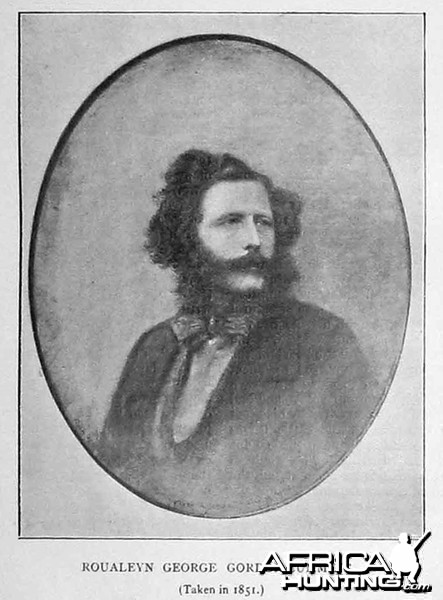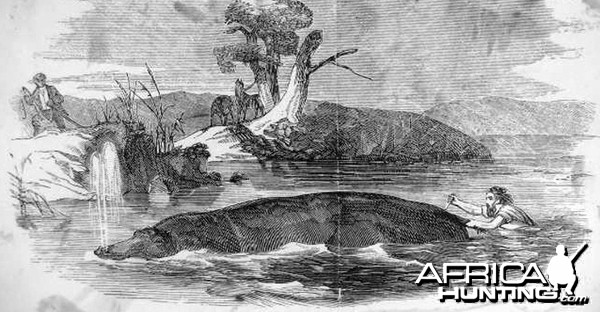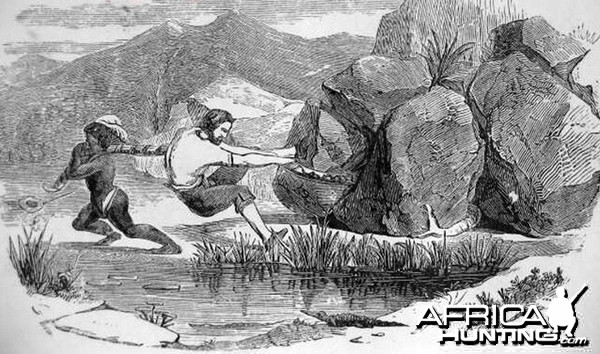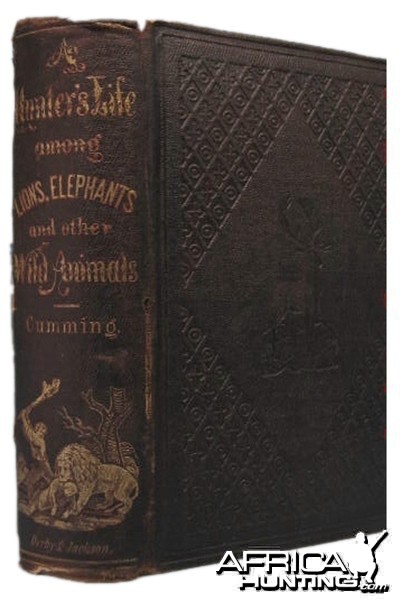monish
AH elite
Roualeyn George Gordon-Cumming (1820-1866) "The Lion Hunter"

Roualeyn George Gordon-Cumming (1820-1866) "The Lion Hunter"
Roualeyn George Gordon-Cumming (1820-1866), Scottish traveller and sportsman, known as the "lion hunter". Born on the 15th March 1820, Roualeyn was the second son of a Scottish baronet, Sir William Gordon-Cumming of Altyre and Gordonstoun. He was educated at Eton.
He had his first taste of sport in Africa in 1838 when he passed through the Cape on his way to India to become a Cornet in the Madras Cavalry. The climate of the Far East did not agree with him. He resigned his commission two years later and returned to Scotland to take up deer stalking. But even the wildest moorside that Scotland could offer proved too tame. He found the life of the wild hunter so far preferable to that of the mere sportsman that he became an Ensign in the Royal Veteran Newfoundland Companies and traveled to North America in season of the bison, the wapiti and the elk. Soon he had transferred to the Cape Mounted Rifles and was back in Africa.
During his stay in the East he had laid the foundation of his collection of hunting trophies and specimens of natural history. In 1843 he joined the Cape Mounted Rifles, but for the sake of absolute freedom sold out at the end of the year and with an ox wagon and a few native followers set out for the interior. He hunted chiefly in Bechuanaland and the valley of the Limpopo River, regions then swarming with big game. In 1848 he returned to the United Kingdom of Great Britain and Ireland.

Drawing from Five years of a hunter's life in the far interior of South Africa by Roualeyn Gordon-Cumming
The story of his remarkable exploits is vividly told in his book, Five Years of a Hunter: Life in the Far Interior of South Africa (London, 1850, 3rd ed. 1851). Of this volume, received at first with incredulity by stay-at-home critics, David Livingstone, who furnished Gordon-Cumming with most of his native guides, wrote: I have no hesitation in saying that Mr. Cumming's book conveys a truthful idea of South African hunting.
His collection of hunting trophies was exhibited in London in 1851 at the Great Exhibition, and was illustrated by a lecture delivered by Gordon-Cumming. The collection, known as The South Africa Museum, was afterwards exhibited in various parts of the country. In 1858 Gordon-Cumming went to live at Fort Augustus, Scotland, on the Caledonian Canal, where the exhibition of his trophies attracted many visitors. He died there in 1866.
Once after wearying his horse in pursuit of an oryx, Cumming confessed: I inwardly wished that, instead of my being a man of fourteen stone weight, nature had formed me of the most Lilliputian dimensions. But his great size, strength and magnificent appearance were an inevitable part of the man who came to be called The Lion Hunter.
After his collection of African trophies weighing more than 27.21 metric tons were shown at the Great Exhibition in London in 1851, he attained great popularity in the U.K. as a lecturer on wild life and the chase.
In his subsequent expeditions as a free-lance adventurer (1843 - 1848) Cumming found the true outlet of his vigorous, independent nature. His Five Years of a Hunters Life in the Far Interior of South Africa (1850) is a boldly descriptive record of courage and perseverance. One critic comments: his volume, written in the romantic British style, is one that will always remain a classic in the world of sporting literature.
According to his own account, Cumming would tackle any animal, using his bare hands if necessary. He once plunged into a pool containing a wounded hippopotamus, cut notches into its flank with his knife and passed leather thongs through the loops thus formed. With the aid of his men he was able to drag it to the land. Even an enormous 4,27 meter python which he discovered retreating into a mass of rocks could not (allegedly) escape the hunter: seizing him by the tail he tried to get him out of his place of refuge. Trophies of his kills were carefully preserved with alum and arsenical soap, a process often carried out under the most trying climatic conditions. (see drawing below)


Cumming returned to Great Britain in 1848 and did not visit South Africa again. In 1858 he settled at Fort Augustus, Inverness, where he established a private museum popular with tourists. A premonition of his end and the ordering of a coffin just before his death , were characteristic of this colourful impetuous adventurer. He died at Fort Augustus on the 24th March 1866, at the age of 46.
An abridgment of his book was published in 1856 under the title of The Lion Hunter of South Africa, and in this form was frequently reprinted, a new edition appearing in 1904.

A Hunter's Life among Lions, Elephants and other Wild Animals by Cumming
Monish
Roualeyn George Gordon-Cumming (1820-1866) "The Lion Hunter"
Roualeyn George Gordon-Cumming (1820-1866), Scottish traveller and sportsman, known as the "lion hunter". Born on the 15th March 1820, Roualeyn was the second son of a Scottish baronet, Sir William Gordon-Cumming of Altyre and Gordonstoun. He was educated at Eton.
He had his first taste of sport in Africa in 1838 when he passed through the Cape on his way to India to become a Cornet in the Madras Cavalry. The climate of the Far East did not agree with him. He resigned his commission two years later and returned to Scotland to take up deer stalking. But even the wildest moorside that Scotland could offer proved too tame. He found the life of the wild hunter so far preferable to that of the mere sportsman that he became an Ensign in the Royal Veteran Newfoundland Companies and traveled to North America in season of the bison, the wapiti and the elk. Soon he had transferred to the Cape Mounted Rifles and was back in Africa.
During his stay in the East he had laid the foundation of his collection of hunting trophies and specimens of natural history. In 1843 he joined the Cape Mounted Rifles, but for the sake of absolute freedom sold out at the end of the year and with an ox wagon and a few native followers set out for the interior. He hunted chiefly in Bechuanaland and the valley of the Limpopo River, regions then swarming with big game. In 1848 he returned to the United Kingdom of Great Britain and Ireland.
Drawing from Five years of a hunter's life in the far interior of South Africa by Roualeyn Gordon-Cumming
The story of his remarkable exploits is vividly told in his book, Five Years of a Hunter: Life in the Far Interior of South Africa (London, 1850, 3rd ed. 1851). Of this volume, received at first with incredulity by stay-at-home critics, David Livingstone, who furnished Gordon-Cumming with most of his native guides, wrote: I have no hesitation in saying that Mr. Cumming's book conveys a truthful idea of South African hunting.
His collection of hunting trophies was exhibited in London in 1851 at the Great Exhibition, and was illustrated by a lecture delivered by Gordon-Cumming. The collection, known as The South Africa Museum, was afterwards exhibited in various parts of the country. In 1858 Gordon-Cumming went to live at Fort Augustus, Scotland, on the Caledonian Canal, where the exhibition of his trophies attracted many visitors. He died there in 1866.
Once after wearying his horse in pursuit of an oryx, Cumming confessed: I inwardly wished that, instead of my being a man of fourteen stone weight, nature had formed me of the most Lilliputian dimensions. But his great size, strength and magnificent appearance were an inevitable part of the man who came to be called The Lion Hunter.
After his collection of African trophies weighing more than 27.21 metric tons were shown at the Great Exhibition in London in 1851, he attained great popularity in the U.K. as a lecturer on wild life and the chase.
In his subsequent expeditions as a free-lance adventurer (1843 - 1848) Cumming found the true outlet of his vigorous, independent nature. His Five Years of a Hunters Life in the Far Interior of South Africa (1850) is a boldly descriptive record of courage and perseverance. One critic comments: his volume, written in the romantic British style, is one that will always remain a classic in the world of sporting literature.
According to his own account, Cumming would tackle any animal, using his bare hands if necessary. He once plunged into a pool containing a wounded hippopotamus, cut notches into its flank with his knife and passed leather thongs through the loops thus formed. With the aid of his men he was able to drag it to the land. Even an enormous 4,27 meter python which he discovered retreating into a mass of rocks could not (allegedly) escape the hunter: seizing him by the tail he tried to get him out of his place of refuge. Trophies of his kills were carefully preserved with alum and arsenical soap, a process often carried out under the most trying climatic conditions. (see drawing below)
Cumming returned to Great Britain in 1848 and did not visit South Africa again. In 1858 he settled at Fort Augustus, Inverness, where he established a private museum popular with tourists. A premonition of his end and the ordering of a coffin just before his death , were characteristic of this colourful impetuous adventurer. He died at Fort Augustus on the 24th March 1866, at the age of 46.
An abridgment of his book was published in 1856 under the title of The Lion Hunter of South Africa, and in this form was frequently reprinted, a new edition appearing in 1904.
A Hunter's Life among Lions, Elephants and other Wild Animals by Cumming
Monish
Last edited by a moderator:

